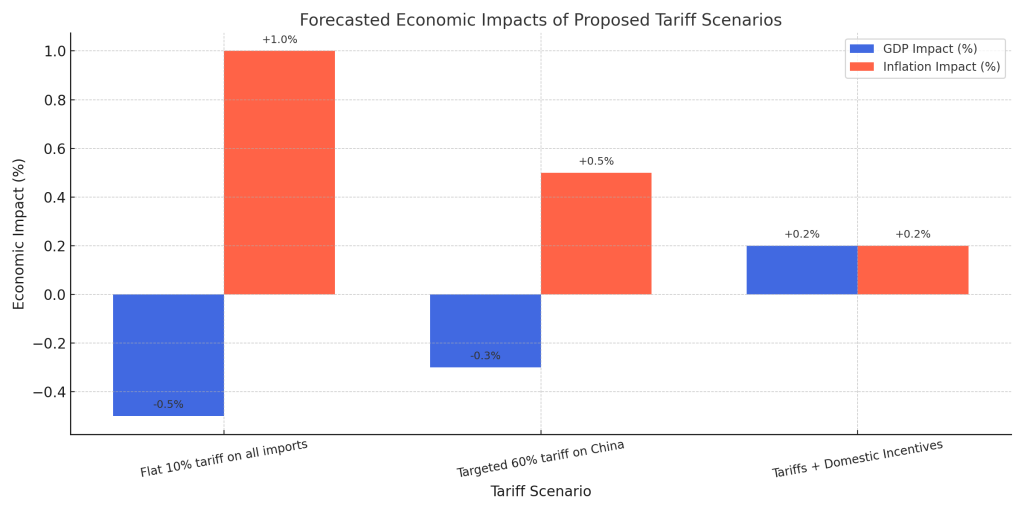🇺🇸 Do Tariffs Help or Hurt? A Deep Dive Into Trump’s Trade Proposal, Economic History & What Comes Next
Dan Stratford Asks ChatGTP
🧭 Introduction
With Donald Trump proposing a universal 10% tariff on all imports—and a 60%+ tariff on goods from China—Americans are again asking:
- Will this bring jobs back?
- Will it protect our economy?
- Or will it raise prices and start trade wars?
This blog explores what happens when tariffs are raised, drawing on historical context, economic theory, real-world examples, and forecast data to determine:
- What good can come from raising tariffs
- What bad outcomes typically follow
- Short-term vs. long-term effects
- Sector-by-sector analysis
- Global case studies of successful and failed tariff policies
- When tariffs actually work
🔍 Part 1: The Pros and Cons of Raising Tariffs
✅ Short-Term Benefits
- Protects domestic industries by making imports more expensive
- Saves jobs in vulnerable sectors like steel and aluminum
- Generates revenue for the government at ports
❌ Short-Term Risks
- Higher prices for consumers on everyday goods
- Disrupts global supply chains for manufacturers
- Triggers retaliation from trade partners (e.g., China, EU)
✅ Long-Term Potential Gains
- Encourages domestic investment and supply chain resilience
- Strengthens national security by reducing dependency
- Improves leverage in trade negotiations
❌ Long-Term Threats
- Industries may become complacent and inefficient
- Tariff-induced inflation reduces consumer purchasing power
- May harm diplomatic relations and global competitiveness
📚 Part 2: What History Tells Us
| Policy | Short-Term Result | Long-Term Outcome |
|---|---|---|
| Smoot-Hawley (1930) | Massive retaliation, exports dropped | Deepened the Great Depression |
| Reagan Tariffs (1980s) | Saved Harley-Davidson, pressured Japan | Led to Japanese FDI in the U.S. |
| Bush Steel Tariffs (2002) | Short boost to steel, hurt other industries | Rescinded after WTO ruling |
| Trump-China Tariffs (2018–2020) | Hurt farmers, raised input costs | Mixed: some reshoring, no major concessions |
🏭 Part 3: Sector-by-Sector Impact
- Manufacturing: Short-term gain for steel, long-term growth if supported
- Auto: Short-term loser, potential winner if EV sector is reshored
- Agriculture: High exposure to retaliation, export loss
- Tech: Short-term disruption, CHIPS Act could help long term
- Construction: Costs rise on materials like steel and lumber
- Retail: Consumer prices increase; niche US-made goods may benefit long term
🌎 Part 4: Global Case Studies
| Country | Strategy | Outcome |
|---|---|---|
| USA (1800s) | Tariffs funded government, protected industry | Led to industrialization |
| Germany | Tariffs protected steel/farming under Bismarck | Helped industrial expansion |
| South Korea | Protected infant industries while promoting exports | Created global brands like Samsung |
| Taiwan | Gradual opening after protectionism | World leader in semiconductors |
| China (pre-WTO) | Protected industry before WTO accession | Gained manufacturing dominance |
| Brazil | Tariffs used in ISI strategy | Built aerospace (e.g., Embraer) |
| India | Protected economy post-independence | Some success, liberalized in 1990s |
📊 Part 5: Economic Forecasts of Tariff Scenarios

| Scenario | GDP Impact | Inflation | Net Jobs | Trade Balance |
|---|---|---|---|---|
| 10% on all imports | -0.5% | +1.0% | -250,000 | Short-term improvement |
| 60% on China | -0.3% | +0.5% | -100,000 | Moderate improvement |
| Tariffs + Investment | +0.2% | +0.2% | +150,000 | Improves over time |
🎯 Part 6: When Tariffs Work
- Targeted and time-limited
- Paired with domestic incentives and innovation
- Used during trade imbalance or foreign dumping
- Supported by diplomacy and reinvestment
🏁 Conclusion
Tariffs are a policy tool—not a silver bullet. Used properly, they can protect key industries and spur growth. Used poorly, they raise prices and provoke retaliation.
Tariffs + Strategy = Potential Growth
Tariffs Alone = Economic Risk

